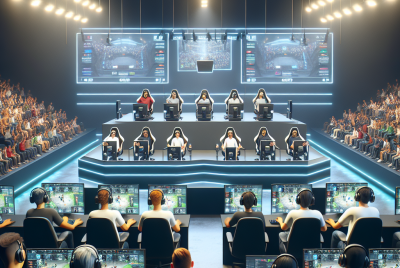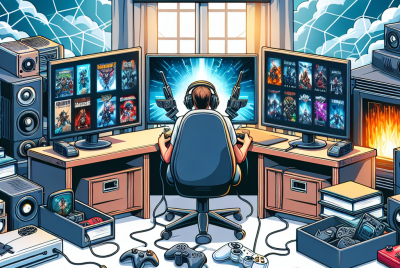How VR Gaming Could Transform Social Interactions
1. The Evolution of Virtual Reality in Gaming
Virtual Reality (VR) gaming has undergone remarkable advancements over the past decade. From clunky headsets to sleek, powerful devices, VR has paved the way for immersive gameplay. These developments transcend mere entertainment; they hold transformative potential for social interactions. As more players enter this realm, understanding how VR gaming reshapes social dynamics becomes essential.
2. Immersive Experiences and Connection
In a traditional gaming environment, players often encounter one another through avatars or usernames. VR, however, fosters an engaging atmosphere where users can interact more authentically. Immersive environments allow players to walk and talk in virtual spaces, significantly enhancing the feeling of presence. Research by the University of Southern California emphasizes how the immersive quality of VR leads to increased empathy and social bonding among participants.
3. Breaking Geographical Barriers
One of VR’s most significant advantages lies in its ability to bridge geographic divides. Friends separated by continents can meet in a virtual café or stadium, collaborating or competing in real-time. This capability not only strengthens existing relationships but also fosters new friendships across cultures. A study published in the “Journal of Computer-Mediated Communication” highlights how virtual settings enable richer social exchanges, enhancing global connectivity.
4. Enhanced Communication through Non-Verbal Cues
Unlike traditional online interactions that rely on text or voice, VR allows for non-verbal communication. Participants can observe body language, facial expressions, and gestures, making interactions more nuanced and genuine. This depth of connection helps in fostering trust and understanding. A simulation study revealed that users felt more connected and accepted when engaging in VR environments compared to traditional online communication platforms.
5. Virtual Events and Gatherings
The advent of VR has facilitated the creation of virtual events, ranging from concerts to gaming tournaments. Platforms such as VRChat and Rec Room enable users to gather in expansive digital spaces, regardless of physical location. Aspects of shared experience—such as attending a concert with friends—foster community and strengthen bonds. Data from Eventbrite showcases a surge in virtual event participation, with VR gatherings being a trending avenue for socialization.
6. Cultivating New Relationships in VR
With the anonymity that online gaming often affords, VR presents a unique opportunity for players to forge meaningful, real-world relationships. Gaming communities are being transformed into social hubs where players share experiences and collaborate on challenges. Successful engagement can lead to friendships that extend beyond the game. The “Computers in Human Behavior” journal notes that VR platforms can significantly enhance social capital within gaming communities by fostering trust and resilience.
7. Educational Opportunities and Workshops
VR gaming is not solely about play; it is also an avenue for learning. Educational institutions use VR to create engaging environments for lessons and workshops. Learners from different backgrounds can meet in a shared space, promoting social interactions while collaborating on projects. For example, VR science simulations allow students to explore complex concepts together, honing their teamwork skills while forming friendships. The integration of VR in education shows a promising collaboration potential that extends beyond the virtual classroom.
8. Team Building and Cooperation
VR promotes teamwork in ways that traditional gaming cannot. Co-op games often require players to strategize, solve problems, and navigate challenges together. This collaboration cultivates stronger interpersonal skills, encouraging players to emerge as leaders and team members. The “Journal of Business Research” asserts that VR-based team-building exercises lead to improved communication and camaraderie among participants. Companies are beginning to leverage VR for corporate training, recognizing its ability to create united teams through shared digital experiences.
9. Therapeutic Community Building
VR’s immersive nature can also support mental health communities. Virtual support groups and therapy sessions can create safe spaces where participants share experiences and emotions. Being within the same virtual space reduces the sense of isolation often felt by individuals dealing with mental health issues. Researchers from Stanford University are exploring VR’s effectiveness in fostering social connections among participants in therapeutic settings, noting its potential for building empathy and group cohesion.
10. Cross-Generational Interactions
The inclusive design of VR gaming platforms invites users from various age groups. Younger generations can engage with older family members in VR environments, breaking down typical age barriers. For instance, family game nights can now take place in fantastical arenas, allowing for bonding experiences that would have been impossible in conventional settings. This cross-generational interaction enriches family relationships, promoting understanding and shared interests.
11. The Influence of Avatars on Social Perception
In VR, players create avatars that represent them in the digital realm. According to the “International Journal of Human-Computer Studies,” avatars’ appearance can significantly impact social perceptions and interactions. Users may choose to disguise their real-life identities, resulting in liberated self-expression and interactions devoid of societal biases. This evolution can encourage users to connect based on personality traits rather than physical attributes, enhancing social dynamics.
12. The Role of Gamification in Social Interactions
Gamification—the application of game-like elements in non-game contexts—heightens user engagement and social interactions in VR settings. This strategy often includes achievements, leaderboards, and rewards that encourage collaboration and competition. By fostering healthy rivalries and teamwork, gamified environments can enhance social interactions within gaming communities. The potential for stunning graphics and interactive experiences can lead to memorable connections that emphasize fun and depth.
13. Language Learning and Cultural Exchange
VR’s capabilities extend to language learning and cultural exchange. Users from distinct linguistic backgrounds can engage in language practice through immersive social interactions. Learning a new language alongside native speakers within a VR setting enhances linguistic skills while cultural exchange promotes understanding and tolerance. Language platforms like ImmerseMe have started using VR to facilitate these experiences, ultimately transforming how individuals connect across cultures.
14. Issues of Privacy and Safety
While the transformation in social interactions is promising, potential concerns regarding privacy and safety remain. Players may unintentionally share personal information or encounter harassment within virtual environments. To address these issues, developers are implementing measures like user reporting systems and customizable privacy settings. Furthermore, discussions surrounding ethical guidelines in VR gaming are crucial to maintaining a safe social atmosphere. Engaging with users on these topics can bolster trust and transparency.
15. The Future of VR Social Interactions
As VR technology continues to evolve, so too will its capacity to foster social interactions. Integration with artificial intelligence and augmented reality could blur the lines between physical and virtual gatherings even further. Emerging technology could shape interactions in ways that are currently unimaginable, leading to innovative social experiences, cooperative projects, and shared memories that transcend virtual boundaries.
By understanding the breadth of VR’s impact on social interactions, stakeholders can harness these developments to foster richer, more meaningful connections among players worldwide. Fostering an environment that encourages safe, positive interactions within VR can pave the way for a more connected, empathetic future. The complexities of social relationships within virtual spaces indicate that VR is not merely a gaming fad; it is a transformative force reshaping how we engage with one another on a global scale.




